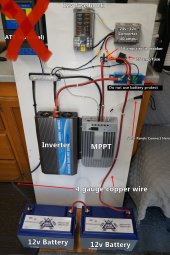It must be rated for higher than 60°C. Please refer to the voltage drop calculator I linked above. If code compliance/best practices is a concern, then you should keep voltage drop below 3%. Lower is better. 10' (each way) of 4awg will produce > 4%. if you 5' (half the length/half the resistance), it will only be 2%.
The goal here is for you to understand how to size wire:
1) pick a wire rated for the current in question.
2) confirm voltage drop is acceptable.
Make sure you then protect the wire with suitable fuses/breakers. Cheap Amazon ones don't cut it. Littlefuse, Bussman and BlueSea Systems are quality brands. LFP batteries typically require class T fuses or quality breakers with a very high AIC rating.
Unfortunately, you've linked a very old picture. He incorrectly used the battery protect in the inverter DC supply circuit - a big no-no, but he clearly noted it. I'm also seeing a 50A circuit breaker on a wire that can clearly see 98A, which is a no-go. If his intention was to never draw more than 1000W from it, it's fine.




